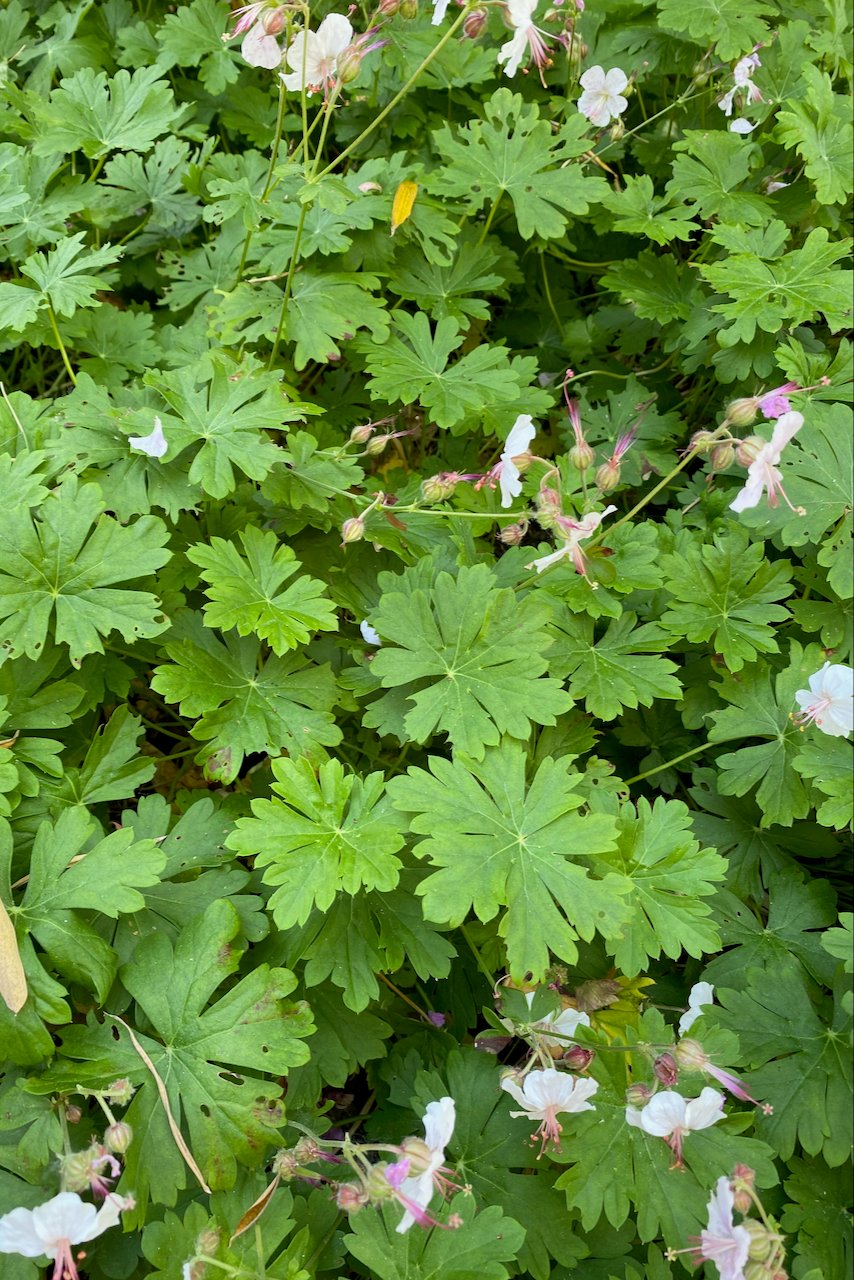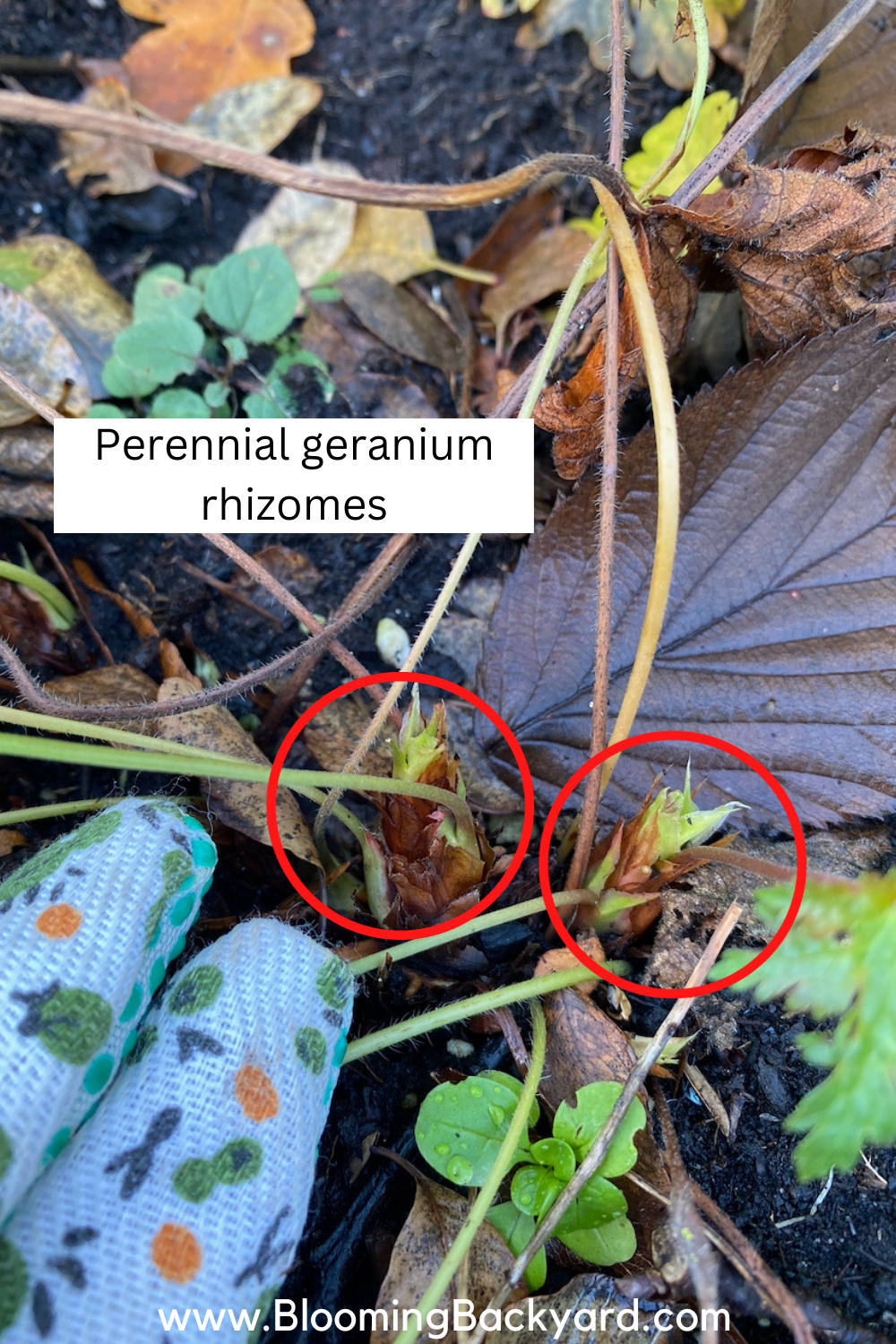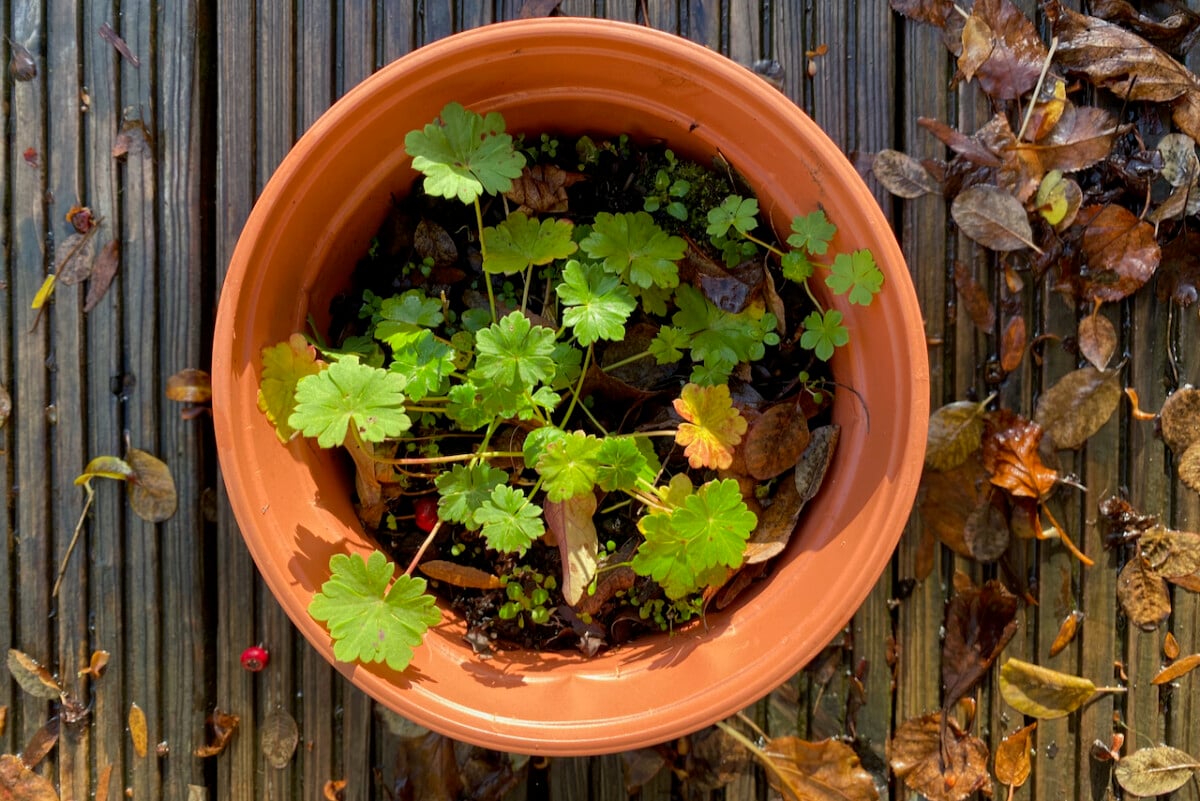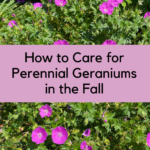
How late is it too late to write a geranium fall care guide?
Usually, if a care guide comes late in the season, it’s because I procrastinate a great deal. I keep thinking and overthinking about the best way to phrase my experience and my advice so that it serves our readers as much as possible. When this happens, I take full responsibility for my procrastinating ways.

This fall, however, I’ll blame the weather for my procrastination. With a warmer than usual fall (even October), my perennial geraniums have stayed in bloom way past their usual peak. Not exactly the right photo op for a fall article.
Now that we’re on the heels of autumn, I got the geranium fall care guide finally ready. And since it’s so late in the season, it will overlap with my planned “how to overwinter a geranium” guide.
Annual geraniums versus perennial geraniums.
Before we get started, I’d like to clarify that I’ll be referring to perennial geraniums in this article. If you’re growing annuals, I’ve already written a guide on how to overwinter tender geraniums. There are quite a few differences between the two groups, which I’ve covered extensively in the article I’ve linked above.

But in a nutshell, when we’re talking about perennial geraniums, we’re referring to hardy geraniums. You may also know them as true geraniums or cranesbill geraniums (because this is what their seed pods look like). These plants belong to the Geranium genus.
How to recognize perennial geraniums?
There are a few surefire ways to distinguish between hardy geraniums (native to Southern Europe and Turkey) and annual geraniums (native to South Africa) that don’t involve seeing if your plant dies over the winter months.
Here’s what to look for:
- The hardy geraniums usually grow from rhizomes; the annual ones usually grow from a fibrous root ball. So if you see rhizomes at the base of the plant, it’s probably a hardy geranium.

- The flowers of the hardy geraniums have five symmetric petals. The flowers of the annual geraniums also have five petals, but they’re arranged in a 2-3 pattern, with two larger upper petals and three smaller lower petals.

- The foliage of perennial geraniums generally spreads low to the ground and has a mounding habit; the annual geraniums usually grow taller along one or several woody stems.
Perennial geraniums are very easy plants to take care of, but there are a few things you should do to help them come back stronger next spring.
1. You can divide your perennial geraniums in the fall.
In general, hardy geraniums are not very fast growers within the same year. So even though they are reliable growers, they won’t take over in a flash. That means that we can let them grow for a few years before we get around to dividing them.

But once you decide they need division, the best time to split the plant is in the fall, right before the plant enters dormancy. Simply dig out the entire root structure, cut it in half with a well-sharpened knife, relocate the spare(s) and replant everything.
When you place your divisions in the ground, it’s a good idea to plant them at the same depth as they were before.

If you’re not keen on being outside in the garden right now, you can also divide your geraniums when spring rolls around.
2. You can take cuttings of your hardy geraniums in the fall.
In my own garden, I’m growing a few cultivars of Geranium macrorrhizum and its own hybrid, Geranium cantabrigiense. I’m biding my time and waiting for them to fill up the space I’ve allotted, so there is no need for me to divide either of them this fall.
But I’ve decided to use hardy geraniums as a ground cover in a new spot next year; so I’m thinking ahead on how I can keep the cost of this project low. If I could do it for free, that would be even better.

Taking hardy geranium cuttings is as easy as finding a rhizome, separating it from the main plant and replanting it in a separate pot. With some perennial geraniums, the rhizomes protrude above ground, so they are easy to see and to cut.
With others, you’ll have to do a bit of digging around the base of the plant in order to find the rhizome. I want a fuller-looking new plant come spring, so I’ve grouped the cuttings together in sets of three and four.
3. Don’t prune your hardy geraniums in the fall.
Even though cranesbill geraniums stay green longer than other perennials, that doesn’t mean they won’t be affected by the cold. Yes, they are hardy. No, they’re usually not an evergreen.

Depending on what climate you’re gardening in, however, the foliage of your hardy geraniums may stay green over the winter months. This happens mostly in gardening zones that don’t experience prolonged frosts. Though it’s more common for the foliage to just die back to the ground and grow back in early spring.
There are some perennial geranium cultivars that turn red in the fall, mimicking the change of leaves that trees experience. In a previous garden, I used to grow Geranium sanguineum, also known as the bloodred geranium, whose leaves turned an absolutely stunning shade of amber and gold in the fall.

Whether your geraniums turn red or go straight to brown, I want to encourage you to skip pruning them this fall. First of all, perennial geraniums generally don’t have a central stalk that needs to be pruned down, as annual geraniums do. The leaves don’t need pruning, since they’ll die back anyway. And when the leaves die back, they’ll act as mulch for the rest of the plant.

You can tidy up the plant in spring, as soon as you notice new foliage starting to grow from the base of the geranium.
4. Mulch your perennial geraniums in the fall.
I’m a big believer in mulching perennials before winter. A lot of gardeners do their main mulching in the spring. First, to prevent evaporation and help the soil retain moisture during the hot months. And secondly, mulching helps with weed suppression.

However, mulching has its uses in the fall as well. Covering the ground with a thick layer of mulch – be it dry leaves, leaf mold or pine needles, will protect the roots of geraniums against fluctuations in temperature. Another advantage of mulching before winter is that it will act as a buffer against the heavy rainfall that contributes to soil compaction.
You can mulch your fall garden for free by collecting fallen leaves and spreading them around. In the absence of leaves, you can opt for wood chips or bark (making sure it’s natural and undyed).
5. Bring new geraniums into your garden.
I’ve been talking about perennial geraniums as a given in the garden. But I know that a lot of gardeners, myself included up until a few years ago, prefer the annual pelargoniums. They simply grow faster and have larger clusters of flowers.
However, if you’re suffering from hardy geranium FOMO, fall is the perfect time to bring some into your garden. You could start them from seed indoors. But keep in mind that they’ll need plenty of light, humidity and warmth to germinate properly. And these things are often in short supply in the winter.

So the next best thing is to buy them as starter plants from garden centers. At this time of year, stores around me run huge sales in order to get rid of their stock supply before winter. Grab a few and plant them as quickly as possible, before the ground freezes.
If you can’t find one you like locally, it’s good to know that you can buy geraniums as bare-root plants or rhizomes. I’ve written a separate guide on the advantages of bare-root planting and how to make the most of this super affordable method.
Geraniums will thrive in well-drained soil. And the good news is that most perennial geraniums will do well in a sunny location, as well as in part shade.

Don’t expect too much growth for the rest of the year. The geraniums will go dormant in the winter. In fact, winter chill is a requirement for these perennials to thrive. But in spring, your plants will already be in place and ready to hit the ground running.
Overall, I would say that hardy geraniums are one of the easiest perennials to care for in the fall and overwinter successfully.

